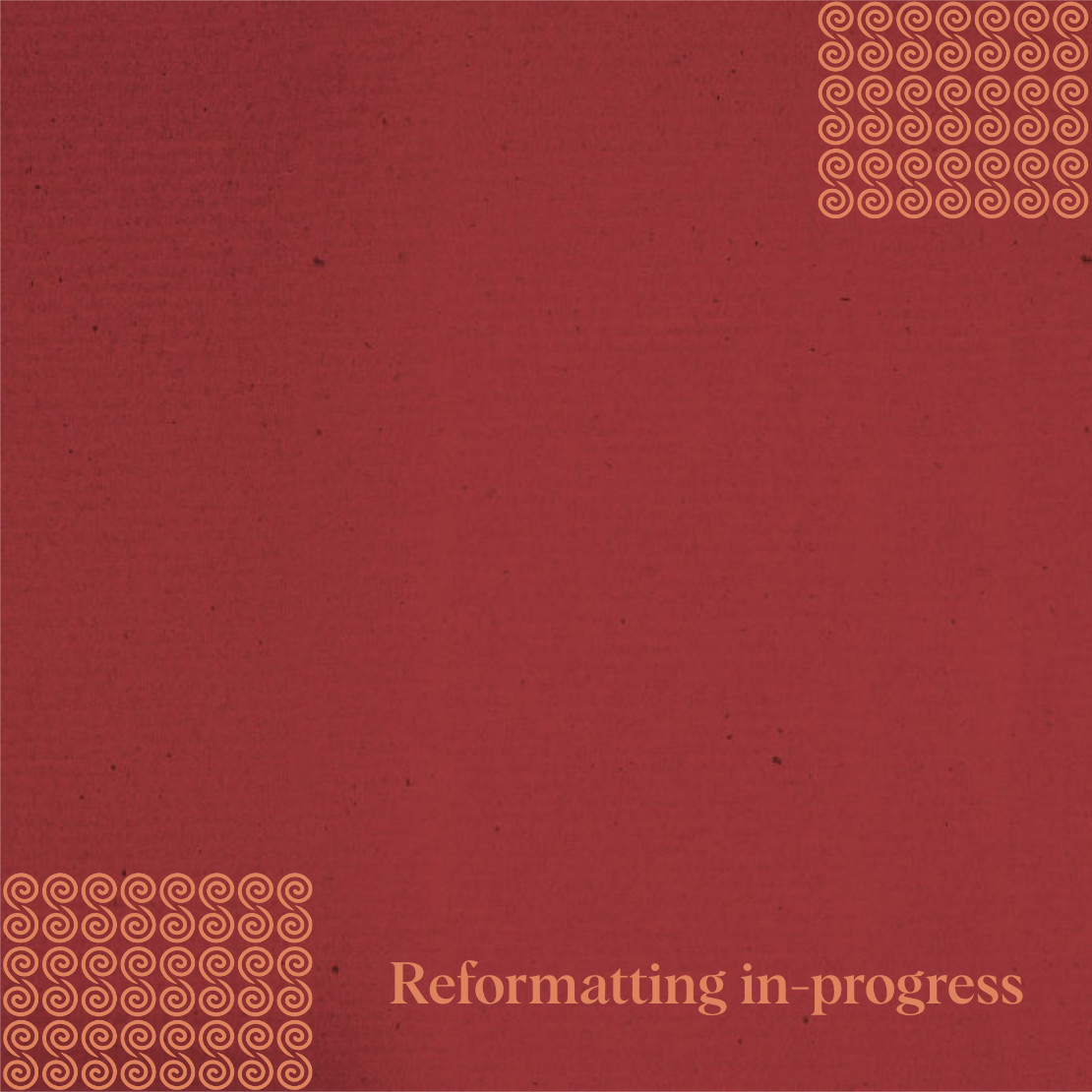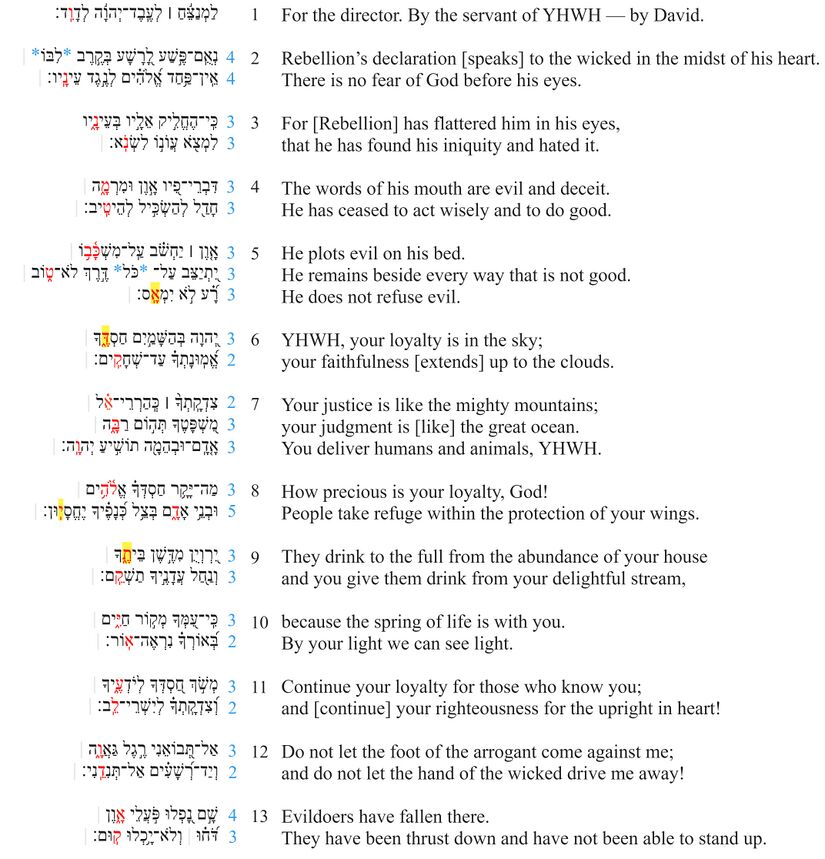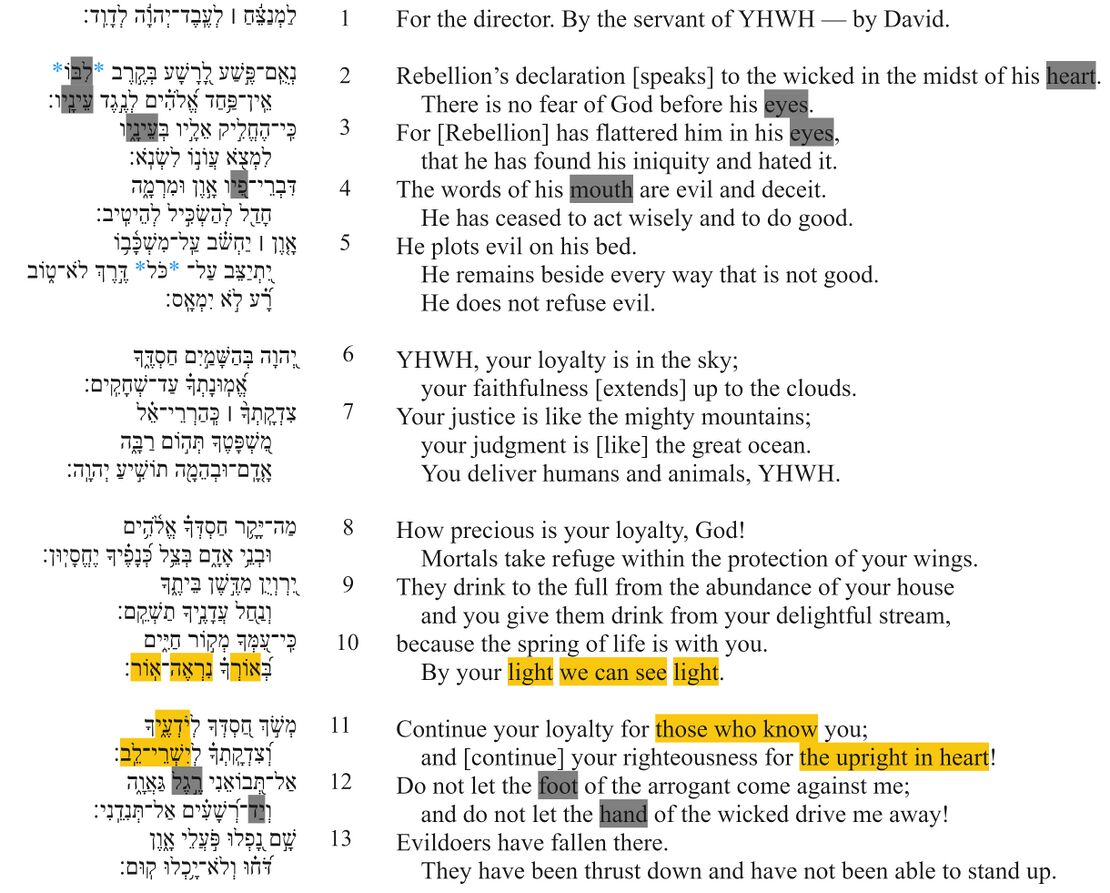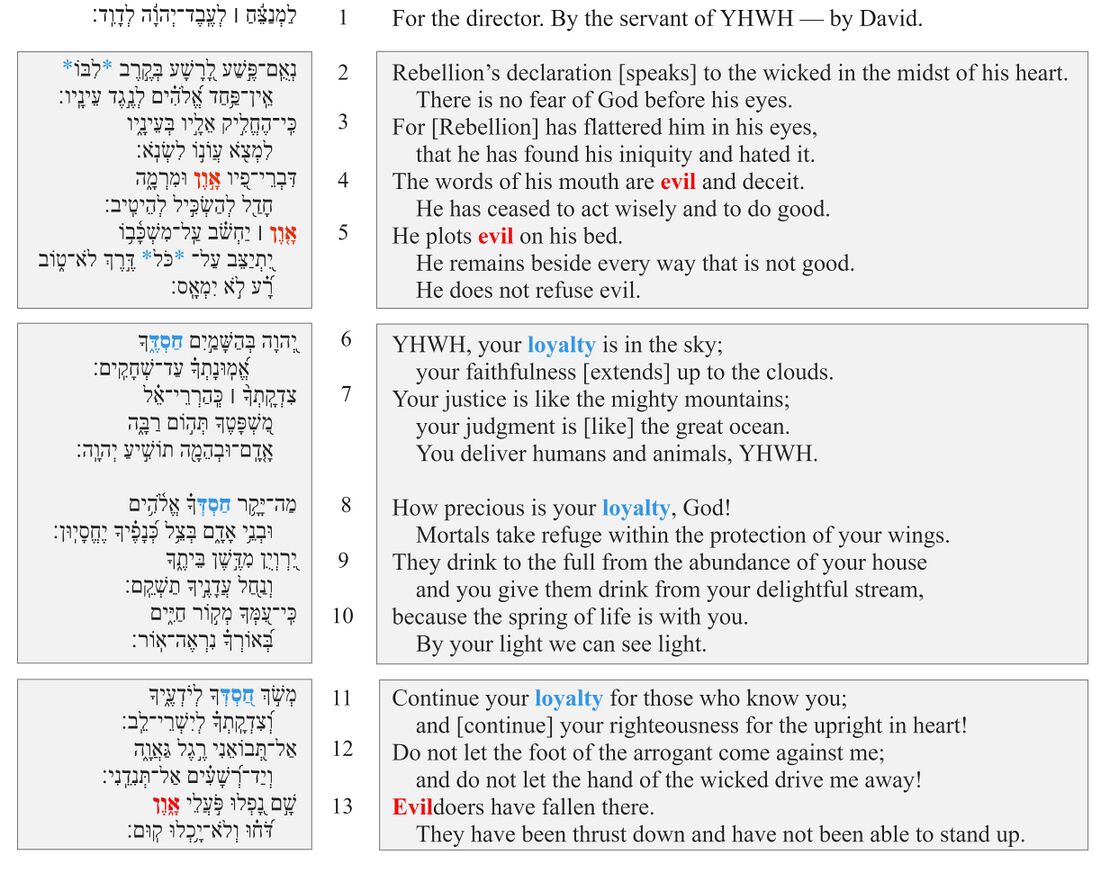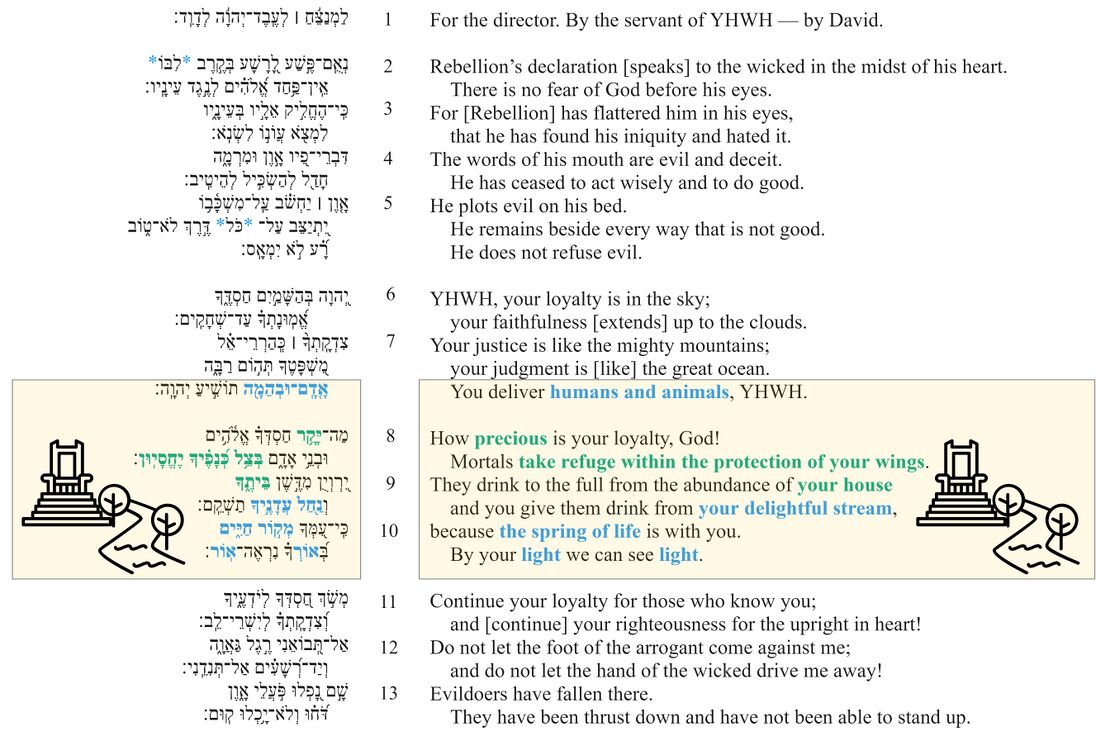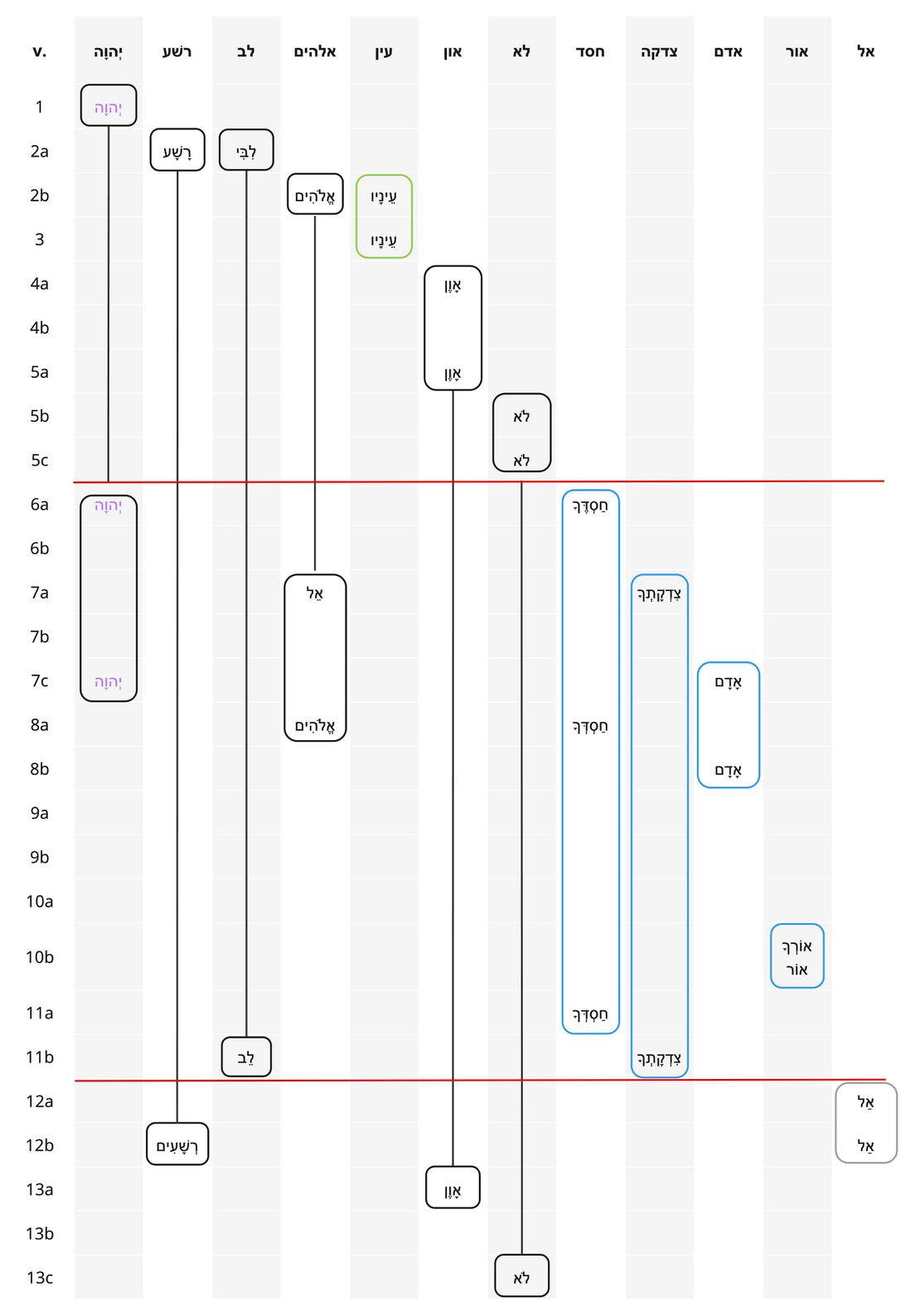Psalm 36 Poetry
About the Poetics Layer
Exploring the Psalms as poetry is crucial for understanding and experiencing the psalms and thus for faithfully translating them into another language. This layer is comprised of two main parts: Poetic Structure and Poetic Features.
Poetic Structure
In poetic structure, we analyse the structure of the psalm beginning at the most basic level of the structure: the line (also known as the “colon” or “hemistich”). Then, based on the perception of patterned similarities (and on the assumption that the whole psalm is structured hierarchically), we argue for the grouping of lines into verses, verses into sub-sections, sub-sections into larger sections, etc. Because patterned similarities might be of various kinds (syntactic, semantic, pragmatic, sonic) the analysis of poetic structure draws on all of the previous layers (especially the Discourse layer).
Poetic Macro-structure
If an emendation or revocalization is preferred, that emendation or revocalization will be marked in the Hebrew text of all the visuals.
| Emendations/Revocalizations legend | |
|---|---|
| *Emended text* | Emended text, text in which the consonants differ from the consonants of the Masoretic text, is indicated by blue asterisks on either side of the emendation. |
| *Revocalized text* | Revocalized text, text in which only the vowels differ from the vowels of the Masoretic text, is indicated by purple asterisks on either side of the revocalization. |
| v. 1 For the director. By the servant of YHWH — by David. | Superscription | |||
| v. 2 Rebellion’s declaration [speaks] to the wicked in the midst of his heart. There is no fear of God before his eyes. | Evil Abounds | Rebellion distorts the perception of the wicked so that he rejects all good and plots only evil. | alarm | |
| v. 3 For [Rebellion] has flattered him in his eyes, that he has found his iniquity and hated it. | ||||
| v. 4 The words of his mouth are evil and deceit. He has ceased to act wisely and to do good. | ||||
| v. 5 He plots evil on his bed. He remains beside every way that is not good. He does not refuse evil. | ||||
| v. 6 YHWH, your loyalty is in the sky; your faithfulness [extends] up to the clouds. | Loyalty Abounds | YHWH is unthreatened. His loyalty extends everywhere and his justice remains firm. | awe | |
| v. 7 Your justice is like the mighty mountains; your judgment is [like] the great ocean. You deliver humans and animals, YHWH. | ||||
| v. 8 How precious is your loyalty, God! Mortals take refuge within the protection of your wings. | YHWH’s loyalty offers people refuge and delight. YHWH’s light enables their perception. | joy | ||
| v. 9 They drink to the full from the abundance of your house and you give them drink from your delightful stream, | ||||
| v. 10 Because the spring of life is with you. By your light we can see light. | ||||
| v. 11 Continue your loyalty for those who know you; and [continue] your righteousness for the upright in heart! | Loyalty Overcomes Evil | YHWH’s continued loyalty protects the upright and ensures evildoers fail. | triumph | |
| v. 12 Do not let the foot of the arrogant come against me; and do not let the hand of the wicked drive me away! | ||||
| v. 13 Evildoers have fallen there. They have been thrust down and have not been able to stand up. | ||||
Notes
- Psalm 36 is typically divided into three sections (vv. 2-5, 6-10, 11-13), the boundaries of which correspond with major shifts in theme and genre: vv. 2-5 describe the wicked person in the vein of the "wisdom tradition"; vv. 6-10 represent a hymn of praise to YHWH; vv. 11-13 are a prayer for help (Lugt 2006, 364). The psalm is framed by a few inclusios: the mention of רשׁע(ים) in vv. 2a and 12b and און in vv. 4a, 5a and 13a; the negatives לא (v. 5b, 5c) and לא/אל (vv. 12, 13b); the clustering of body part terms (vv. 2, 3a, 4a and 11b, 12). On a smaller scale, חַסְדְּךָ "your loyalty" begins three distinct sections (vv. 6-7, 8-10, 11-13) and functions as "the backbone and focus of the psalmist’s praise" in these sections (NICOT 2014, 345). Its absence in the section describing the wicked person (vv. 2-5) is perhaps not coincidental; the wicked person does not/cannot receive the blessing of YHWH's חסד "loyalty."
- vv. 2-5: The psalm's first section describes the wicked person via the clustering of third-person suffixes (vv. 2a, 2b, 3a [x2], 3b, 4a, 5a), body part terms (v. 2a - לב; vv. 2b, 3a - עין; v. 4a - פה) and sin terms (v. 2a - פשׁע, רשׁע; v. 3a - עון; vv. 4a, 5a - און, v. 4a - מרמה; v. 5c - רע). The lines within each line grouping contain the same amount of words, creating a prosodic balance which supports the notion that vv. 2-5 form a discrete unit.
- vv. 6-10:The division between v. 5 and v. 6 is not only supported by a thematic shift (i.e., description of wicked person to praise of YHWH), but perhaps also by a ms fragment found at Qumran, 4Q83, in which there appears to be a space interval between these verses. Elsewhere in 4Q83, similar space intervals signal the beginning of a new psalm, so "perhaps the scribe considered verse 6 as beginning a new Psalm," or at the very least a new section of the same psalm (DJD XVI, 14). Vv. 6-10 can be subdivided as follows:
- Vv. 6-7 "constitutes the meaningful centre" of the entire psalm and "is significantly delimited by the 2 occurrences of the name YHWH functioning as a device for inclusion" (Labuschagne 2006, 1). That "YHWH" is reserved for the section devoted to his praise and is nowhere to be found in the section describing the wicked person (vv. 2-5) indicates visually/poetically the real distinction between the wicked person and YHWH: as in the poem, so also in life, YHWH has no dealings with the wicked.
- Vv. 8-10 are bracketed by similar sounds (מ, ק, ר, ח) within the expressions מַה־יָּקָר חַסְדְּךָ (v. 8a) and מְקוֹר חַיִּים (v. 10a). This section also features the second mention of אלהים, however the sense here of "divine beings" is different than the previous mention of אלהים "God" (v. 2b).
- vv. 11-13: The final section is demarcated by the opening imperative מְשֹׁךְ "continue" and by its classification as a prayer for help (Lugt 2006, 361). This is the only section in which first-person language appears, which is fitting for a prayer. This section also displays a clustering of imperatives (vv. 11a, 12ab), representing the only imperatives in the psalm.
Line Divisions
Line division divides the poem into lines and line groupings. We determine line divisions based on a combination of external evidence (Masoretic accents, pausal forms, manuscripts) and internal evidence (syntax, prosodic word counting and patterned relation to other lines). Moreover, we indicate line-groupings by using additional spacing.
When line divisions are uncertain, we consult some of the many psalms manuscripts which lay out the text in lines. Then, if a division attested in one of these manuscripts/versions influences our decision to divide the text at a certain point, we place a green symbol (G, DSS, or MT) to the left of the line in question.
| Poetic line division legend | |
|---|---|
| Pausal form | Pausal forms are highlighted in yellow. |
| Accent which typically corresponds to line division | Accents which typically correspond to line divisions are indicated by red text. |
| | | Clause boundaries are indicated by a light gray vertical line in between clauses. |
| G | Line divisions that follow Greek manuscripts are indicated by a bold green G. |
| DSS | Line divisions that follow the Dead Sea Scrolls are indicated by a bold green DSS. |
| M | Line divisions that follow Masoretic manuscripts are indicated by a bold green M. |
| Number of prosodic words | The number of prosodic words are indicated in blue text. |
| Prosodic words greater than 5 | The number of prosodic words if greater than 5 is indicated by bold blue text. |
If an emendation or revocalization is preferred, that emendation or revocalization will be marked in the Hebrew text of all the visuals.
| Emendations/Revocalizations legend | |
|---|---|
| *Emended text* | Emended text, text in which the consonants differ from the consonants of the Masoretic text, is indicated by blue asterisks on either side of the emendation. |
| *Revocalized text* | Revocalized text, text in which only the vowels differ from the vowels of the Masoretic text, is indicated by purple asterisks on either side of the revocalization. |
Notes
- v. 2 - An atnaḥ is present in MT's לִבִּ֑י.
- v. 3 - The A line is one of two lines (v. 8b) in Ps 36 that does not end with a clause boundary. That the A line ends with an atnaḥ justifies its separation from the B line.
- v. 5b - Without the emendation, this line includes three prosodic words (יִתְיַצֵּב עַל־דֶּרֶךְ לֹא־טוֹב); with the emendation, the line could still include three prosodic words if עַל־כֹּל־דֶּ֣רֶךְ was joined by maqqefs (for כל and דרך joined by maqqef, cf. Pss 91:11; 119:168: 139:3; 145:17).
- v. 8 - Greek and Masoretic witnesses group אֱלֹ֫הִ֥ים with the A line, resulting in the following line division: A - מַה־יָּקָ֥ר חַסְדְּךָ֗ אֱלֹ֫הִ֥ים and B - וּבְנֵ֥י אָדָ֑ם בְּצֵ֥ל כְּ֝נָפֶ֗יךָ יֶחֱסָיֽוּן. According to this division, the A line contains three prosodic words and three stressed syllables; the B line contains five prosodic words and five stressed syllables. If, instead, v. 8 is divided into three lines in which אֱלֹ֫הִ֥ים is grouped with the B line, the resulting word and stressed syllable counts are more balanced: A - two prosodic words, two stressed syllables; B - three prosodic words, three stressed syllables; C - three prosodic words, three stressed syllables. The division of v. 8 into three lines is preferred based on such prosodic balance and the grammatical grouping of אֱלֹ֫הִ֥ים and וּבְנֵ֥י אָדָ֑ם as a compound subject (see Grammar note).
Poetic Features
In poetic features, we identify and describe the “Top 3 Poetic Features” for each Psalm. Poetic features might include intricate patterns (e.g., chiasms), long range correspondences across the psalm, evocative uses of imagery, sound-plays, allusions to other parts of the Bible, and various other features or combinations of features. For each poetic feature, we describe both the formal aspects of the feature and the poetic effect of the feature. We assume that there is no one-to-one correspondence between a feature’s formal aspects and its effect, and that similar forms might have very different effects depending on their contexts. The effect of a poetic feature is best determined (subjectively) by a thoughtful examination of the feature against the background of the psalm’s overall message and purpose.
(Im)perception
If an emendation or revocalization is preferred, that emendation or revocalization will be marked in the Hebrew text of all the visuals.
| Emendations/Revocalizations legend | |
|---|---|
| *Emended text* | Emended text, text in which the consonants differ from the consonants of the Masoretic text, is indicated by blue asterisks on either side of the emendation. |
| *Revocalized text* | Revocalized text, text in which only the vowels differ from the vowels of the Masoretic text, is indicated by purple asterisks on either side of the revocalization. |
Feature
Throughout the Psalter, participants are often characterized by body-part terms and imagery (see Gillmayr-Bucher 2004). Certain body-part terms, such as לֵב "heart" and עַיִן "eye," pertain to one's perception. The purpose of body-part terms and imagery in Ps 36 is to (1) negatively characterize Rebellion's influence on the wicked (vv. 2, 3, 4, 12) and (2) positively characterize YHWH's influence on his people (vv. 10, 11).
Effect
With reference to the wicked, body-part terms and imagery create a negative characterization: their heart (v. 2), eyes (vv. 2, 3), mouth (v. 4), feet (v. 12), and hands (v. 12) are either affected by or are instruments of evil. Rebellion's influence results in faulty perception; their "heart" and "eyes" or "knowledge and understanding" are completely corrupted so that they cannot perceive the fear of God (v. 2b) or the truth about their sin (v. 3a) (Avrahami 2012, 158). Rebellion's influence completely corrupts the wicked, extending from their mind to their mouth (v. 4a) and finally to their hands and feet (v. 12), which are instruments of "purposeful activity" (Pilch and Malina 2016). Having been completely corrupted, the wicked are destroyed (v. 13).
Whereas the wicked are influenced by Rebellion, YHWH's people are influenced by him and therefore have unimpaired perception. Only by YHWH's light (i.e., favor) can his people see light (i.e., experience life, prosperity) themselves (v. 10b). Having eyes that see, they also have a mind that knows YHWH personally (v. 11a). And having eyes that see and a mind that knows, they have a heart that is pure and upright (v. 11b).
The body-part terms and imagery in Ps 36 depict the negative influence of Rebellion and its consequences and the positive influence of YHWH and its consequences. Rebellion leads to faulty perception, even death (v. 13); YHWH leads to right perception and life (v. 10b).
Loyalty (חֶסֶד) vs. Evil (אָוֶן)
If an emendation or revocalization is preferred, that emendation or revocalization will be marked in the Hebrew text of all the visuals.
| Emendations/Revocalizations legend | |
|---|---|
| *Emended text* | Emended text, text in which the consonants differ from the consonants of the Masoretic text, is indicated by blue asterisks on either side of the emendation. |
| *Revocalized text* | Revocalized text, text in which only the vowels differ from the vowels of the Masoretic text, is indicated by purple asterisks on either side of the revocalization. |
Feature
The terms אָוֶן and חֶסֶד each occur three times in this psalm. Regarding their distribution, אָוֶן occurs twice (vv. 4, 5) in the opening section and once (v. 13) in the final section; חֶסֶד occurs twice (vv. 6, 8) in the middle section and once (v. 11) in the final section. So the first section contains two mentions of אָוֶן, the middle section two mentions of חֶסֶד, and the final section one mention of each.
Effect
The distribution of אָוֶן and חֶסֶד reveals that: אָוֶן characterizes the speech (v. 4), mind (v. 5), and actions (v. 13) of the wicked, whereas חֶסֶד characterizes YHWH and his actions (vv. 6, 8, 11). The contrast is not between YHWH's people and the wicked, rather YHWH's חֶסֶד and the אָוֶן of the wicked. Their distribution exhibits a progression across the psalm's three sections. The seemingly unbridled אָוֶן of the wicked person (vv. 2-5) is interrupted by the unbounded חֶסֶד of YHWH (vv. 6-10), which prompts the question: which will prevail, חֶסֶד or אָוֶן?
The third and final section, where both terms appear together for the first time, provides the answer: חֶסֶד triumphs over אָוֶן, for חֶסֶד and אָוֶן cannot coexist. Thus any doubt as to which will prevail in the first two sections is laid to rest in the third and final section, where YHWH's people experience the continuation of his חֶסֶד in the destruction of their enemies.
Also of significance may be the psalmist's creative use of מְשֹׁךְ, which could iconically represent the "continuing" of YHWH's חֶסֶד from the first two sections into the third and final section. YHWH's חֶסֶד is not to remain within the Edenic temple (vv. 8-10) but to extend forth from it to the realm of the wicked, that is, outside the temple. It is indeed "there" (v. 13) — outside the temple — where the wicked fall down dead.
YHWH's Edenic Temple
If an emendation or revocalization is preferred, that emendation or revocalization will be marked in the Hebrew text of all the visuals.
| Emendations/Revocalizations legend | |
|---|---|
| *Emended text* | Emended text, text in which the consonants differ from the consonants of the Masoretic text, is indicated by blue asterisks on either side of the emendation. |
| *Revocalized text* | Revocalized text, text in which only the vowels differ from the vowels of the Masoretic text, is indicated by purple asterisks on either side of the revocalization. |
Feature
In vv. 8-10, imagery of the temple and creation/Eden (Gen 1-2) abounds. Regarding the temple, mortals "take refuge within the protection of [YHWH's] wings" (v. 8; cf. Ps 61:5), which is a metaphor for finding safety in YHWH's temple, that is, his "house" (v. 9). Imagery of creation/Eden is used to depict the blessings within YHWH's temple: there is a "delightful stream" (v. 9; Gen 2:10), a "spring of life" (v. 10; Gen 2:7), and "light" (v. 10; Gen 1:3).
Additionally, "humans and animals" could represent the first instance of creation/Eden imagery, as well as provide a structural link from vv. 6-7 to vv. 8-10. The description of YHWH's devotion as "precious" (v. 8) perhaps alludes to the "precious" stones used to construct the temple (1 Kgs 5:31).
Effect
The combination of temple and creation/Eden imagery is not unique to Ps 36 (cf. Ezek 47:1-12). The idea that a river/stream flows out of both the temple (Ezek 47) and Eden (Gen 2:10) comes together in v. 9, in which "a marvelous stream" representing "the natural mechanism for the distribution of divine favor" is enjoyed by YHWH's people within the temple precincts (Levenson 1976, 28). The defining characteristic of this stream is its manifold delights (עֲדָנֶי), which is the same characteristic — rather the same name (!) — of Eden itself, "delight" (עֵדֶן).
In vv. 8-10, the Edenic temple functions as the "place where God succors man, in short, a paradise" (Ibid). As at the beginning of creation in Eden, it is the place where "life" (cf. Gen 2:7) and "light" (cf. Gen 1:3) abound. In light of the threat of the wicked (vv. 2-5), the Edenic temple of Ps 36 functions as a place of refuge and safety. YHWH's people cannot be harmed within the temple precincts, for there the presence of YHWH prevents the אָוֶן of the wicked from entering. The Edenic temple — completely filled with YHWH's חֶסֶד and completely devoid of אָוֶן — is the place where YHWH continues his חֶסֶד for his people and destroys those who do אָוֶן (v. 13).
Repeated Roots
The repeated roots table is intended to identify the roots which are repeated in the psalm.
| Repeated Roots legend | |
|---|---|
| Divine name | The divine name is indicated by bold purple text. |
| Roots bounding a section | Roots bounding a section, appearing in the first and last verse of a section, are indicated by bold red text. |
| Roots occurring primarily in the first section are indicated in a yellow box. | |
| Roots occurring primarily in the third section are indicated in a blue box. | |
| Roots connected across sections are indicated by a vertical gray line connecting the roots. | |
| Section boundaries are indicated by a horizontal black line across the chart. | |
Notes
- Descriptions of the wicked cluster at the beginning and end of the psalm: רשׁע (vv. 2a, 12b); און (vv. 4a, 5a, 13a). They create a frame around the middle section, the shape of which emerges from the clustering of descriptions/attributes of YHWH: חסד (vv. 6a, 8a, 11a); צדקה (vv. 7a, 11b). Seen this way the psalms proceeds from the wicked, to YHWH, then back to the wicked; the centerpiece of the psalm concerns descriptions/attributes of YHWH.
- Of note is the absence of the divine name (יהוה) or "God" (אלהים) at the beginning and end of the psalm, precisely where the descriptions of the wicked are located (if the superscription is considered, יהוה occurs once in v. 1). Perhaps the absence of the divine name in these sections, and its presence is the middle section which is about him, reflects the perspective of the psalmist — that YHWH is absent from the wicked.
- Although they are not content words, the negative particles לא (v. 5b, 5c, 13c) and אל (v. 12a, 12b) cluster at the beginning and end of the psalm where the descriptions of the wicked are located. Not listed on the repeated roots chart is another negative particle, אין, which occurs once at the beginning in the section describing the wicked (v. 2b). Interestingly, no negative particles appear in the section concerning YHWH and his people (vv. 6-12). Perhaps the psalmist, via the clustering of these negative particles, intends to associate wicked people with things that are "not," that is, bad things. For the wicked, "there is no fear of God" (v. 2b), they "stand beside every way that is not good" (v. 5b), and they "do not reject evil" (v. 5c). The psalmist requests that the wicked "not come to him" (v. 12a), "not drive him away" (v. 12b), and he expresses confidence that they "will not be able to stand" (v. 13c).
- Besides YHWH, only two groups of people are represented by repeated roots: the wicked — רשׁע "wicked person" (v. 2a); רשׁעים "wicked people" (v. 12b) and mankind — אדם "man" (v. 7c); בני) אדם) "(children of) man" (v. 8b). As related in note #2 above, of note is the absence of the divine name in the sections concerning the wicked and the presence of the divine name in the section concerning mankind.
- There are no repeated verbs, only nouns, adjectives, and negative particles.
Bibliography
- Avrahami, Yael. 2012. The Senses of Scripture: Sensory Perception in the Hebrew Bible. New York: Bloomsbury Publishing.
- Botha, P.J. 2004. “The Textual Strategy and Ideology of Psalm 36.” Old Testament Essays 17 (4): 506–20.
- Carasik, Michael. 2005. Theologies of the Mind in Biblical Israel. New York: Peter Lang.
- Craigie, Peter C. 2004. Psalms 1–50. 2nd ed. WBC 19. Nashville, TN: Nelson Reference & Electronic.
- DeClaissé-Walford, Nancy L., Rolf A. Jacobson, and Beth LaNeel Tanner. 2014. The Book of Psalms. NICOT. Grand Rapids: William B. Eerdmans Publishing Company.
- Delitzsch, Franz. 1871. Biblical Commentary on the Psalms: Vol. 2. Translated by Francis Bolton. Edinburgh: T & T Clark.
- de Regt, Lénart J. 1996. “Discourse Implications of Rhetorical Questions in Job, Deuteronomy and the Minor Prophets.” In Literary Structure and Rhetorical Strategies in the Hebrew Bible. Assen: Van Gorcum.
- Honeyman, A. M. 1952. “Merismus in Biblical Hebrew.” Journal of Biblical Literature 71 (1): 11–18.
- Jenni, Ernst. 2000. Die Hebräischen Präpositionen Band 3: Die Präposition Lamed. Stuttgart: Verlag W. Kohlhammer.
- Keel, Othmar. 1997. The Symbolism of the Biblical World: Ancient Near Eastern Iconography and the Book of Psalms. Winona Lake, IN: Eisenbrauns.
- Khan, Geoffrey, and Christo H.J. Van Der Merwe. 2020. “Towards A Comprehensive Model For Interpreting Word Order In Classical Biblical Hebrew.” Journal of Semitic Studies 65 (2): 347–90.
- Kim, Young Bok. 2023. Hebrew Forms of Address: A Sociolinguistic Analysis. Atlanta: SBL Press.
- Kraus, Hans-Joachim. 1988. Psalms 1-59: A Commentary. Minneapolis: Augsburg Pub. House.
- Kselman, John S. 1997. "Psalm 36." In Wisdom, You Are My Sister: Studies in Honor of Roland E. Murphy, O. Carm., On the Occasion of His Eightieth Birthday. Washington, DC: Catholic Biblical Association of America.
- Labuschagne, Casper J. 2006. https://www.labuschagne.nl/ps036.pdf
- LeMon, Joel M. 2010. Yahweh’s Winged Form in the Psalms: Exploring Congruent Iconography and Texts. Fribourg, Göttingen: Academic Press; Vandenhoeck & Ruprecht.
- Locatell, Christian S. 2017. “Grammatical Polysemy in the Hebrew Bible: A Cognitive Linguistic Approach to כי.” PhD Dissertation, Stellenbosch: University of Stellenbosch.
- Miller-Naudé, Cynthia L., and C. H. J. van der Merwe. 2011. “הִנֵּה and Mirativity in Biblical Hebrew.” Hebrew Studies 52:53–81.
- Pilch, John J., and Bruce J. Malina, eds. 2016. Handbook of Biblical Social Values. 3rd edition. Eugene, OR: Cascade Books.
- Ryken, Leland, Jim Wilhoit, Tremper Longman, Colin Duriez, Douglas Penney, and Daniel G. Reid, eds. 1998. Dictionary of Biblical Imagery. Downers Grove, IL: InterVarsity Press.
- Van der Merwe, Christo H.J. 2023. “The Conceptualization of Heart as an Active Zone Body Part in Biblical Hebrew.” In Where Is the Way to the Dwelling of Light?: Studies in Genesis, Job and Linguistics in Honor of Ellen van Wolde. Leiden: Brill.
- Ziegert, Carsten. 2020. “What Is חֶ֫סֶד? A Frame-Semantic Approach.” Journal for the Study of the Old Testament 44 (4): 711–32.
